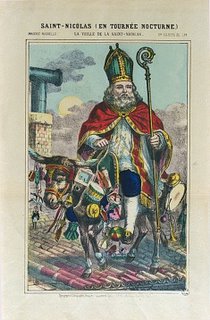Ante Diem VII Idus December

Modern Date : December 7th
Ante Diem VII Idus December
Seventh Day to the Ides of December
This is one of the dies comitiales when committees of citizens could vote on political or criminal matters.
On this day in 43 BCE, the greatest Roman orator, Cicero, was beheaded at Formiae while attempting to leave Italy, by order of Mark Antony, in the consulship of Hitius and Pansa. Cicero had angered Antony by his famous speeches, the Phillipics, that called for a restoration of the Republic. Mark Antony ordered his hands cut off after his death -- the hands that had written the speeches.
The festivities of the Faunalia continued on this day. This festival was more popularly celebrated in rustic areas, being a celebration of nature and animals. The people celebrated this festival with a dance done in triple measure, the same dance done by the priests of Salii, the priests of Mars. Faunus was the grandson of Cronus (Saturn). He was worshipped as the god of fields and sheperds, and as a prophetic god.
Decima, the middle Fate in charge of the present, presides over December, but the month may have received its name as the tenth month of the Roman calendar. Vesta, patroness of fire also laid claim to the month of December.
Haloia of Demeter
On this date in ancient Greece, an annual rite called the Haloia of Demeter was performed. According to mythology, each year the goddess Demeter wanders the earth in search of her stolen daughter Persephone. The goddess' sorrow brings Winter to the world and all trees and flowers cease to bloom; however, Spring returns when Persephone is allowed to temporarily leave the darkness of the Underworld and Demeter once again rejoices.
St Leonard's Ride
In Bavaria, people dress up in native costume and decorate their horses in preparation for a festive procession in honor of St Leonard, the patron of cattle. They march with their cattle in the procession, led by white horses, while singing and cracking whips. It is possible this date was once associated with a cattle sacrifice.
St Leonard is also the patron of women in childbirth, because it was said that when the wife of the King went into labor suddenly while hunting in the woods, St Leonard came out of his hermit's cell to pray for her and she was safely delivered. He is also the patron of prisoners, and when invoked by those who have been unjustly imprisoned, he brings about their freedom.
La Quema del Diablo
Guatemalans are habitual victims of early spring cleaning. By late afternoon on 7 December each year, the eve of the Fiesta de La Virgen de Inmaculada Concepción (Feast day of the Virgin of the the Immaculate Conception), town and cityfolk will have cleared their homes of all unwanted bits and pieces and erected vast heaps of rubbish outside on the streets that are said to represent the devil.
By 6pm the piles are set alight and throngs of onlookers gather round to celebrate an ancient tradition called La Quema del Diablo (The Burning of the Devil). Guatemalans strongly believe that by burning the rubbish they are purging their homes and towns of evil. This fire and brimstone ritual is interestingly a throwback to 18th century Catholic folklore and represents the Virgin of the Immaculate Conception's merciless struggle with the devil.

